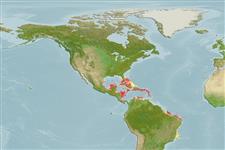Common names from other countries
Classification / Names / Names
Populärnamn | synonymer | Catalog of Fishes (gen., sp.) | ITIS | CoL | WoRMS
Environment: milieu / climate zone / depth range / distribution range
Ekologi
Revassocierade; brackvatten; djupintervall 9 - 12 m (Ref. 108813). Tropical
Western Central Atlantic.
Length at first maturity / Size / Vikt / Age
Maturity: Lm ? range ? - ? cm Max length : 50.0 cm TL hane/ej könsbestämd; (Ref. 415)
Laterally fused tubes running on branches (Ref. 81728): up to 50 cm long, 10 - 20 cm in diameter. Light to purplish brown externally, yellow to tan internally. The surface is smooth, with meandering groves occasionally. Oscules on the inner walls of the tubes few millimeters in diameter (Ref. 415).
Coral reefs, usually below 10 m in depth (Ref. 415). Also occurs in mangrove ponds (Ref. 86789).
Life cycle and mating behavior
Könsmognad | Reproduktion | Lek | Ägg | Fecundity | Larver
Members of the class Demospongiae are hermaphroditic. Life cycle: The zygote develops into parenchymella larva (free-swimming) before settling down on a substrate where it grows into a young sponge.
Collin, R., M.C. Díaz, J. Norenburg, R.M. Rocha, J.A. Sánchez, M. Schulze, A. Schwartz and A. Valdés. 2005. (Ref. 415)
IUCN Red List Status (Ref. 130435)
CITES status (Ref. 108899)
Not Evaluated
Not Evaluated
Threat to humans
Harmless
Human uses
| FishSource |
Verktyg
Ytterligare information
Age/SizeTillväxtLength-weightLength-lengthMorfologiLarverAbundans
Internet-källor
Estimates based on models
Preferred temperature
(Ref.
115969): 26.1 - 28.1, mean 27 (based on 188 cells).
Vulnerability
Moderate vulnerability (40 of 100).
Price category
Unknown.
